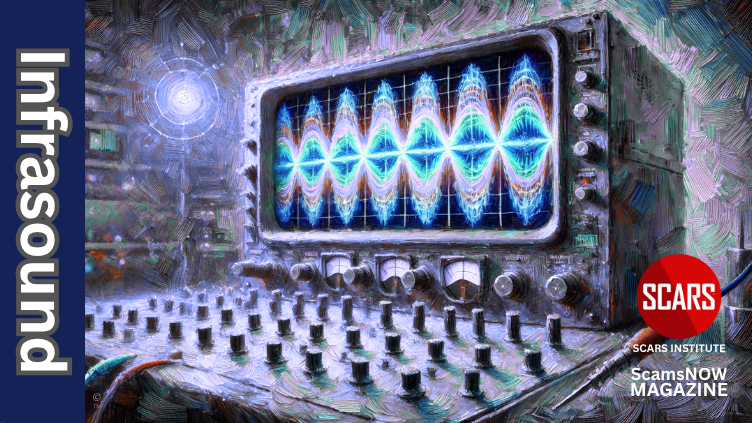Infrasound – Possible New Tool for Scammers to Improve Grooming, Manipulation, and Control of Scam Victims
Exploring A Possible New Scammer Technique to Manipulate and Control Scam Victims’ Emotions
Primary Category: Psychology of Scams / Criminology / Scammer Techniques
Author:
• Tim McGuinness, Ph.D., DFin, MCPO, MAnth – Anthropologist, Scientist, Polymath, Director of the Society of Citizens Against Relationship Scams Inc.
About This Article
Infrasound, sound waves below 20 Hz, can influence human emotions and physiology, potentially aiding scammers in manipulating victims, according to research and insights from the SCARS Institute. Studies, including a 2003 experiment by Richard Wiseman, show that infrasound at 17 Hz caused 22 percent of 750 concertgoers to experience unease, sorrow, or fear, suggesting it can trigger emotional vulnerability. The SCARS Institute has identified infrasound in scam-related video and audio files, indicating scammers may use these frequencies to enhance grooming by inducing disorientation or anxiety, thus accelerating trust-building.
Infrasound’s effects, such as dizziness, fatigue, and reduced cognitive clarity, can impair critical thinking, making victims more susceptible to tactics like urgency or fake authority. Generating infrasound is simple with tools like online tone generators, and it can be embedded in digital media, though consumer devices may limit its intensity. While no direct studies link infrasound to scamming, its ability to evoke stress responses aligns with grooming’s emotional manipulation. Scam victims can counter this by learning to recognize manipulative tactics through education, as supported by psychological inoculation research, ensuring resilience against such covert techniques.

Exploring Infrasound: A Possible New Scammer Technique to Manipulate and Control Scam Victims’ Emotions
Overview of Infrasound and Psychological Manipulation
Infrasound refers to sound waves below the human hearing threshold, typically under 20 Hz. These low-frequency vibrations can be produced by natural phenomena (e.g., wind, earthquakes) or human-made sources (e.g., machinery, wind turbines, subwoofers). While inaudible, infrasound can affect humans physiologically and psychologically, causing sensations like unease, pressure, or disorientation. Research on infrasound’s psychological effects is limited but growing, particularly in contexts like environmental noise, health, and paranormal experiences.
Psychological manipulation, in the context of scams, involves tactics like grooming, where scammers build trust to exploit victims emotionally or financially. Grooming often relies on emotional triggers (e.g., urgency, trust, fear) and cognitive biases, as seen in romance or investment scams. The question of whether infrasound could enhance grooming speed—by making victims more suggestible or emotionally vulnerable—is speculative but worth exploring given infrasound’s documented effects on mood and perception.
Physiological and Cognitive Effects
Beyond subjective feelings, infrasound can produce measurable somatic (bodily) effects and alter physiological responses. Participants in infrasonic experiments have reported peculiar physical sensations: “shivering on my wrist,” an odd fluttering in the stomach, or a spike in heart rate accompanied by anxiety. In Wiseman’s concert study, some listeners experienced a sudden memory of grief or waves of dread for no apparent reason, suggesting infrasound can tap into deep emotional circuits. These responses often mimic the body’s natural fight-or-flight reaction (e.g. adrenaline, heart palpitations, tense unease) even though no visible threat exists.
Scientific observations back up these reports. At certain frequencies and amplitudes, infrasound can induce vestibular disturbances – essentially upsetting the inner ear and balance system. Researchers at Sydney University’s Auditory Neuroscience Lab found evidence that infrasonic stimulation of the vestibular system produces effects similar to motion sickness (dizziness, nausea) in both humans and animals. Infrasound from large wind turbines, for instance, has been associated anecdotally with nausea, headaches, dizziness and fatigue in sensitive individuals. Complaints from low-frequency noise exposures include pressure in the ears, a feeling of chest vibration or “pulsation,” and even difficulty breathing or heart palpitations at higher intensities. Notably, these symptoms are often non-specific stress reactions, analogous to the bodily stress from whole-body vibration.
Crucially, cognitive clarity can also be impaired. Volunteers exposed to very low-frequency tones (around 5–10 Hz) at high decibel levels have shown changes in brain activity and performance. In one experiment, a 6 Hz infrasonic tone (115 dB) caused hearing subjects to exhibit EEG patterns of “diminished wakefulness” (a drowsy, dream-like state), along with changes in pulse and blood pressure. The same exposure did not affect deaf subjects, implying the effect was mediated through the auditory/vestibular system. Test subjects in this low-frequency range also reported an inability to concentrate, memory problems, or general confusion during exposure. Even at more moderate sound levels, people living near persistent infrasound sources have described difficulty concentrating, irritability, and impaired task performance when the low-frequency noise is present. At extreme intensities, the effects become more dramatic: early NASA research on rocket noise (0.5–40 Hz vibrations up to ~160 dB) noted motor ataxia (loss of muscle coordination), visual disturbances (blurring), problems with speech communication, and severely degraded cognitive task performance in subjects exposed to infrasonic “noise” in the 2–3 Hz range. In essence, a strong infrasonic assault can overload the vestibular and nervous system, leading to disorientation and mental fog. Even at lower levels, the subtle brain-stem arousal from infrasound may make it harder to think clearly, as the body is put on edge.
Taken together, these findings show that infrasound doesn’t just produce spooky feelings – it can also trigger bodily stress responses (fast heartbeat, hormone release), disturb the inner ear (causing vertigo-like symptoms), and erode mental focus. The person may simply feel uneasy, tired, or unable to think straight, without realizing a physical acoustic source underlies these effects.
How Infrasound Produces These Effects: Key Mechanisms
Why does a low-frequency vibration cause such profound sensations? Researchers have identified several mechanisms by which infrasound interacts with the body’s systems:
Resonance with Body Organs (Eye and Internal Organs): Every object has resonant frequencies at which it naturally vibrates – and this includes human organs. Notoriously, the eyeball has a resonant frequency around ~18 Hz. Infrasonic waves near this frequency can literally make the eyeballs vibrate, leading to visual distortions. For example, Vic Tandy’s “ghost” sighting in a 18.9 Hz-infused lab was explained by a standing wave resonating his eyes, causing a fleeting blur or illusion in peripheral vision. Other body cavities (chest, abdomen) also resonate at infrasonic frequencies, especially under high sound pressure. Strong low-frequency sound can cause chest and abdominal vibrations, creating sensations of pressure or internal shaking. These vibrations may in turn stimulate the vagus nerve and other autonomic nerves. The vagus nerve, which runs from brainstem to visceral organs, helps regulate heart rate and gut feelings – unusual stimulation of this pathway might produce symptoms like nausea, “flutters” or even faintness (vasovagal response). Indeed, reports of low-frequency noise exposure have included heart palpitations, dizziness, and even swooning (fainting) in extreme cases, consistent with excessive autonomic activation.
Vestibular System Stimulation: The inner ear’s vestibular organs (otoliths and semicircular canals) are responsible for balance and detecting motion. Infrasound can directly stimulate the vestibular system, essentially tricking the body into sensing movement that isn’t there. Very low frequencies (below ~1 Hz) can induce a sense of sway or sea-sickness – one study noted participants exposed to 2–7 Hz tones (at high volume) felt a bodily rocking or dizziness, and even exhibited involuntary eye movements (nystagmus) as if they were motion sick. This mechanism explains the nausea, dizziness and disorientation some people experience: the infrasonic waves are activating the balance system aberrantly, causing confusion between the ears and the brain similar to when on a rocking boat. Some investigators theorize that large infrasonic sources (like wind turbines) essentially cause a subset of people to experience chronic motion-sickness-like symptoms via vestibular pathways.
Whole-Body Vibration and Stress Response: Infrasound at sufficient intensity literally shakes the body, even if imperceptibly. Our skin and organs contain mechanoreceptors tuned to vibration, but they are relatively insensitive to low frequencies unless the sound pressure is high. When intense infrasound does vibrate the body (e.g. >120 dB at low Hz), it can produce a cascade of physiological stress effects. Experiments in the 5–10 Hz range have noted decreased cerebral blood flow, shallow or irregular respiration, and changes in blood pressure during exposure. These correspond to the body’s acute stress reaction, sometimes called the “startle” or alarm response. Even if the person isn’t consciously alarmed, the body treats the low-frequency vibration like a warning signal, releasing stress hormones and heightening arousal. This internal state manifests as feelings of unease, irritability, or fatigue for the individual. In short, the infrasonic wave induces a mild form of whole-body stress. If sustained, this can wear down a person’s concentration and mood, as described earlier.
Psychological Interpretation (Cognitive Appraisal): Another important factor is that infrasound is stealthy: people do not consciously hear a low hum, yet their body reacts. This disconnect can lead the mind to misinterpret the source of the feelings. Human brains seek an explanation for sudden dread or awe: absent a known physical cause, people may turn to paranormal or religious explanations. As Professor Wiseman noted, infrasonic vibrations at haunted sites could make people feel odd sensations “that they attribute to a ghost”. Likewise, someone in a cathedral might feel an overwhelming spiritual awe without realizing the organ’s infrasonic bass notes are a physiological trigger. Because the emotional response is real but the cause is hidden, infrasound can bypass critical filters – the fear or awe is accepted at face value, potentially making the person more open to suggestions about what it means.
Infrasound, Suggestibility, and Manipulation
The combination of induced emotion, physical disorientation, and diminished clarity can increase a person’s vulnerability to psychological manipulation. High arousal states (like fear or awe) tend to make individuals more receptive to ideas or guidance from others. When someone is anxious, confused, or in awe, their critical thinking is often lowered – the mind’s priority shifts to seeking comfort, explanation, or leadership. Unscrupulous individuals can exploit this by providing their desired interpretation or commands at the opportune moment. Below are a few ways in which infrasound-induced states could be leveraged by manipulative figures:
Cult Leaders Enhancing Obedience: A cult or religious leader could and have intentionally used infrasonic sound during ceremonies or gatherings to amplify the emotional atmosphere.
For instance, hidden devices emitting a 17 Hz undertone (or simply the acoustics of a large drum or didgeridoo) might induce a background sense of awe, trembling, or fear among followers. The group, not consciously hearing anything, might interpret their goosebumps and racing hearts as a sign of the leader’s spiritual power or the presence of a divine force. This awe-stricken, fearful state can make followers less prone to skepticism and more inclined to embrace the leader’s messages. Psychologically, the induced anxiety and physiological stress can also foster dependency; members look to the leader for safety and answers while in this uncomfortable state. In theory, a cult leader could thereby heighten suggestibility and group cohesion by using infrasound to keep followers in a subservient, emotionally-charged mindset.
Paranormal Fraud and “Hauntings”: The link between infrasound and ghostly sensations is well documented, and this could be exploited by fraudsters such as fake psychics, “haunted house” operators, or extortionists. By covertly introducing an infrasonic hum into an environment, a manipulator can cause people present to start feeling uneasy, watched, or frightened for no obvious reason. They may even glimpse fleeting shadows (thanks to vibrating eyes) or hear an uncanny rumble just below audibility. Once the seed of fear is planted physiologically, the fraudster can swoop in with a narrative – “There’s an angry spirit here” or “Only I can remove the curse causing these feelings.” Because the victims are truly experiencing anxiety and chills (courtesy of the infrasound), they are more likely to accept the supernatural explanation and comply with the fraudster’s demands (be it paying for a “cleansing” ritual or following the psychic’s advice). Their critical thinking is hampered by the stress and ambiguity of the situation. This scenario illustrates how an understanding of infrasound’s effects could aid in engineering a convincing illusion, making victims literally feel the lie.
Intimidation and Crowd Control: There are historical rumors and research into using infrasound as a form of sonic weapon or crowd control device. While the practical difficulties (requiring large equipment and precise conditions) have limited real-world deployment, one can imagine a manipulative authority figure or regime using low-frequency noise to induce discomfort and compliance. In a closed environment (say, an interrogation room or a contained protest), directing an infrasonic emitter at subjects could make them feel disoriented, anxious, and exhausted. This can break down psychological resistance.
For example, an interrogator might use a barely detectable infrasonic tone to make a detainee too unfocused and uneasy to resist leading questions, effectively lowering their mental defenses. Similarly, a propagandist could introduce infrasound into propaganda broadcasts or rallies to evoke a visceral emotional response (like patriotic awe or existential fear), thereby bypassing rational analysis of the message. These applications remain largely theoretical or anecdotal, but they underscore the criminological potential of infrasonic influence. In essence, fear is a tool, and infrasound provides a way to inject fear (or confusion) directly into people’s bodies.
Research on Infrasound and Psychological Effects
Research on infrasound’s psychological impact provides some insights, though no studies directly link it to scamming or grooming. Key findings include:
Annoyance and Discomfort:
A 1984 study by Henrik Møller exposed 16 subjects to infrasound (audible and inaudible) for three hours. Audible infrasound caused significant annoyance and ear pressure at levels less than 20 dB above the hearing threshold, but inaudible infrasound had no effect. Performance on psychological tasks was minimally impacted, with deterioration in only one of nine tasks.
Implications: Annoyance or discomfort from infrasound could heighten emotional vulnerability, potentially making victims more susceptible to manipulative tactics, though this is untested.
Unusual Sensations and Paranoid Experiences:
Vic Tandy and Tony Lawrence’s 1998 paper, “Ghosts in the Machine,” [see PDF below] suggested that infrasound (around 19 Hz) at certain intensities can induce odd sensations, such as unease or a feeling of being watched, often attributed to hauntings. Richard Wiseman’s experiments supported this, noting that infrasound increased the intensity of haunting-like experiences in controlled settings, like Mary King’s Close in Edinburgh.
Implications: If scammers could deploy infrasound to create unease, it might amplify fear or trust-based manipulation, potentially accelerating grooming by destabilizing victims emotionally. However, no evidence suggests scammers use this tactic.
Physiological and Psychological Effects:
A 2021 study exposed 38 participants to 6 Hz infrasound (80–90 dB) for 28 nights, finding no significant behavioral changes but a trend toward reported physical weakness (p = 0.083). Brain imaging showed grey matter decreases in the cerebellum and angular gyrus, though these were not linked to harm or improvement.
A 2024 review summarized infrasound’s effects, noting associations with annoyance, sleep disturbances, and cardiovascular strain at high sound pressure levels, but minimal evidence for effects below perception thresholds.
Implications: Subtle physiological effects, like fatigue or sleep disruption, could reduce cognitive clarity, potentially making victims more prone to impulsive decisions during grooming, though this is speculative.
Infrasound and Grooming Speed in Scams
No research has yet directly investigated whether scammers use infrasound to enhance grooming speed. However, we can evaluate the plausibility based on infrasound’s effects and scam psychology:
Theoretical Mechanism:
Emotional Vulnerability: Infrasound’s ability to cause unease, annoyance, or fatigue could theoretically heighten emotional states like fear or anxiety, which scammers exploit. For example, romance scammers use “love bombing” or fear tactics to cloud judgment, and infrasound-induced discomfort might amplify these effects.
Cognitive Impairment: Sleep disturbances or physical weakness from infrasound exposure could reduce critical thinking, making victims more susceptible to urgency or authority biases, common in scams.
Grooming Acceleration: Grooming often takes weeks or months (e.g., 6–8 months in romance scams). If infrasound could make victims more emotionally reactive or less skeptical, it might shorten the trust-building phase, though no data confirms this.
Evidence:
No governmental studies or reports document scammers using infrasound. Research on scam psychology focuses on cognitive biases (e.g., authority bias, reciprocity) and emotional manipulation (e.g., fear, hope), with no mention of acoustic techniques. However, the SCARS Institute has found examples of fake scammer videos containing prequencies in the 10 to 19Hz range.
Research on infrasound shows it can cause psychological effects like annoyance, unease, or fatigue at audible or high-intensity levels, but no studies connect it to scamming or grooming yet.
According to NBC News
Infrasound linked to spooky effects
Natural sounds at frequencies so low they can’t be consciously heard by humans may be behind the feelings and phenomena associated with hauntings, scientists say.Mysteriously snuffed out candles, weird sensations and shivers down the spine may not be due to the presence of ghosts in haunted houses but to very low frequency sound that is inaudible to humans. British scientists have shown in a controlled experiment that the extreme bass sound known as infrasound produces a range of bizarre effects in people including anxiety, extreme sorrow and chills — supporting popular suggestions of a link between infrasound and strange sensations.
“NORMALLY YOU can’t hear it,” Richard Lord, an acoustic scientist at the National Physical Laboratory in England who worked on the project, said Monday.
Lord and his colleagues, who produced infrasound with a 23-foot (7-meter) pipe and tested its impact on 750 people at a concert, said infrasound is also generated by natural phenomena.
“Some scientists have suggested that this level of sound may be present at some allegedly haunted sites and so cause people to have odd sensations that they attribute to a ghost — our findings support these ideas,” said Professor Richard Wiseman, a psychologist at the University of Hertfordshire in southern England.
REACTIONS TO INFRASOUND
Lord and Wiseman played four contemporary pieces of live music, including some laced with infrasound, at a London concert hall and asked the audience to describe their reactions to the music.
The audience did not know which pieces included infrasound, but 22 percent reported more unusual experiences when it was present in the music.
Their unusual experiences included feeling uneasy or sorrowful, getting chills down the spine or nervous feelings of revulsion or fear.
“These results suggest that low frequency sound can cause people to have unusual experiences even though they cannot consciously detect infrasound,” said Wiseman, who presented his findings to the British Association science conference.
NATURAL PHENOMENON
Infrasound is also produced by storms, seasonal winds and weather patterns and some types of earthquakes. Animals such as elephants also use infrasound to communicate over long distances or as weapons to repel foes.
“So much has been said about infrasound — it’s been associated with just about everything from beam weapons to bad driving. It’s wonderful to be able to examine the evidence,” said Sarah Angliss, a composer and engineer who worked on the project.
Effects on Humans
Richard Wiseman’s study on infrasound investigated the effects of low-frequency sounds (infrasound) on human emotions and experiences. The study found that when infrasound was present in music, participants reported more unusual experiences, such as feeling uneasy or sorrowful, chills down the spine, or nervous feelings. These effects were observed even among participants who were unaware of the infrasound’s presence.
Silent sounds hit emotional chords
Scientists have found a way to add a spine-tingling dimension to modern music. They played an experimental organ pipe too low to be heard and then collected reports of strange reactions – sorrow, coldness, anxiety and shivers down the spine.
They were playing with infrasound, the point at which an instrument resonates at an inaudible frequency. The experiment was conducted during concerts of contemporary music at the Purcell Room in central London.
“Infrasound has been suggested as weaponry because it has potentially negative effects on people as it vibrates the. Some people have suggested the presence of infrasound is causing unusual experiences in sites that are allegedly haunted,” said Richard Wiseman, a psychologist at University of Hertfordshire, who will outline the research at the British Association festival.
“Some organ pipes in churches and cathedrals produce infrasound and this could lead to people having very weird experiences within church and attributing it to God. We wanted to try to assess some of these claims.”
The guinea pigs were 750 concertgoers who turned up to listen to music by Philip Glass, Pärt, Debussy and more recent composers – including Sarah Angliss, who joined the scientists in devising the experiment. Humans hear at a range of frequencies from 20kilohertz down to 20hertz – lower than a bat’s squeak, higher than a whale’s rumble. But some organ pipes produce frequencies as low as 16.4 herz.
To test the theory that infrasound could trigger sensations, the researchers worked with physicists to add silent notes to parts of the music. They also handed questionnaires to the concertgoers to see if any unusual sensations coincided with inaudible bass lines.
One of the ghost instrumentalists monitoring the bad vibes was Richard Lord of the National Physical Laboratory. “It was a double blind experiment. I didn’t even know, before the concert, which pieces the infrasound was going to be in.”
The audience reported 22% more “unusual experiences” during those pieces accompanied by infrasound. They reported “shivering on my wrist, an odd feeling in the stomach, increased heart rate, feeling very anxious, a sudden memory of an emotional loss,” said Prof Wiseman.
Natural sources of infrasound – wind, air conditioning systems and traffic for example – could possibly explain why there were persistent reports of hauntings in some buildings. But the environment would affect the attribution, he said.
“If you walked into a modern building and suddenly felt sort of ill but didn’t know why, it might be sick building syndrome. If you walk into an old Scottish castle with a reputation, that’s a ghost.”
Easy to Implement
Devices
It is possible to produce frequencies below 20 Hz on electronic devices like smartphones and computers, though they may not be audibly perceived by humans. These frequencies are considered infrasound, and while devices can generate them, the perception depends on factors like speaker quality and the listener’s sensitivity.
Device Capabilities: Smartphones and computers are capable of producing frequencies outside the typically audible range (20 Hz – 20 kHz).
Infrasound: Frequencies below 20 Hz are categorized as infrasound.
Perception: While some people may perceive infrasound through vibrations, it is generally not heard in the traditional sense.
Speaker Limitations: The size and design of speakers in smartphones and computers are not optimized for low-frequency sound production, but they can still generate infrasound.
Generation
A web-based infrasound generator allows anyone to create and manipulate inaudible low-frequency sounds using a web browser. These generators can be used for various applications, including research, art, and even experimentation with how the human body and mind react to infrasonic frequencies. While not all applications are fully web-based, some offer web interfaces for controlling and interacting with the generator.
For Example: You can easily generate and save an infrasound audio file that can be added to a video or audio recording and then sent to a scam victim. Here is some such tool: https://onlinetonegenerator.com/
References
- https://www.iflscience.com/the-infrasonic-17-hz-tone-experiment-induced-revulsion-and-fear-in-participants-77093
- https://www.nbcnews.com/id/wbna3077192
- https://www./science/2003/sep/08/sciencenews.science
- https://richardwiseman.wordpress.com/research/psychology-of-ghosts-and-hauntings/
- https:///wiki/Infrasound
- https://www.abc.net.au/news/2003-09-08/soundless-music-shown-to-produce-weird-sensations/1475258
- https://en.wikipedia.org/wiki/Suggestibility
- https://www.iflscience.com/the-infrasonic-17-hz-tone-experiment-induced-revulsion-and-fear-in-participants-77093
- https://www.wind-watch.org/documents/infrasound-public-health-and-welfare-criteria-for-noise/
- https://www.audioholics.com/room-acoustics/bass-the-physical-sensation-of-sound
The Ghost in the Machine
Published in the Journal of the Society for Psychical Research – Vol.62, No 851 April 1998
Authors: Vic Tandy, School of International Studies and Law, Coventry University; Tony R. Lawrence, School of Health and Social Sciences, Coventry University
Please Rate This Article
Please Leave Us Your Comment Below
Also, tell us of any topics we might have missed.
-/ 30 /-
What do you think about this?
Please share your thoughts in a comment above!
ARTICLE RATING
TABLE OF CONTENTS
CATEGORIES
U.S. & Canada Suicide Lifeline 988
![NavyLogo@4x-81[1] Infrasound - Possible New Tool for Scammers to Improve Grooming, Manipulation, and Control of Scam Victims - 2025](https://scamsnow.com/wp-content/uploads/2025/04/NavyLogo@4x-811.png)
ARTICLE META
One Comment
Leave A Comment
Important Information for New Scam Victims
- Please visit www.ScamVictimsSupport.org – a SCARS Website for New Scam Victims & Sextortion Victims.
- SCARS Institute now offers its free, safe, and private Scam Survivor’s Support Community at www.SCARScommunity.org – this is not on a social media platform, it is our own safe & secure platform created by the SCARS Institute especially for scam victims & survivors.
- SCARS Institute now offers a free recovery learning program at www.SCARSeducation.org.
- Please visit www.ScamPsychology.org – to more fully understand the psychological concepts involved in scams and scam victim recovery.
If you are looking for local trauma counselors, please visit counseling.AgainstScams.org
If you need to speak with someone now, you can dial 988 or find phone numbers for crisis hotlines all around the world here: www.opencounseling.com/suicide-hotlines
Statement About Victim Blaming
Some of our articles discuss various aspects of victims. This is both about better understanding victims (the science of victimology) and their behaviors and psychology. This helps us to educate victims/survivors about why these crimes happened and not to blame themselves, better develop recovery programs, and help victims avoid scams in the future. At times, this may sound like blaming the victim, but it does not blame scam victims; we are simply explaining the hows and whys of the experience victims have.
These articles, about the Psychology of Scams or Victim Psychology – meaning that all humans have psychological or cognitive characteristics in common that can either be exploited or work against us – help us all to understand the unique challenges victims face before, during, and after scams, fraud, or cybercrimes. These sometimes talk about some of the vulnerabilities the scammers exploit. Victims rarely have control of them or are even aware of them, until something like a scam happens, and then they can learn how their mind works and how to overcome these mechanisms.
Articles like these help victims and others understand these processes and how to help prevent them from being exploited again or to help them recover more easily by understanding their post-scam behaviors. Learn more about the Psychology of Scams at www.ScamPsychology.org
SCARS INSTITUTE RESOURCES:
If You Have Been Victimized By A Scam Or Cybercrime
♦ If you are a victim of scams, go to www.ScamVictimsSupport.org for real knowledge and help
♦ SCARS Institute now offers its free, safe, and private Scam Survivor’s Support Community at www.SCARScommunity.org – this is not on a social media platform, it is our own safe & secure platform created by the SCARS Institute especially for scam victims & survivors.
♦ Enroll in SCARS Scam Survivor’s School now at www.SCARSeducation.org
♦ To report criminals, visit https://reporting.AgainstScams.org – we will NEVER give your data to money recovery companies like some do!
♦ Follow us and find our podcasts, webinars, and helpful videos on YouTube: https://www.youtube.com/@RomancescamsNowcom
♦ Learn about the Psychology of Scams at www.ScamPsychology.org
♦ Dig deeper into the reality of scams, fraud, and cybercrime at www.ScamsNOW.com and www.RomanceScamsNOW.com
♦ Scam Survivor’s Stories: www.ScamSurvivorStories.org
♦ For Scam Victim Advocates visit www.ScamVictimsAdvocates.org
♦ See more scammer photos on www.ScammerPhotos.com
You can also find the SCARS Institute’s knowledge and information on Facebook, Instagram, X, LinkedIn, and TruthSocial
Psychology Disclaimer:
All articles about psychology and the human brain on this website are for information & education only
The information provided in this and other SCARS articles are intended for educational and self-help purposes only and should not be construed as a substitute for professional therapy or counseling.
Note about Mindfulness: Mindfulness practices have the potential to create psychological distress for some individuals. Please consult a mental health professional or experienced meditation instructor for guidance should you encounter difficulties.
While any self-help techniques outlined herein may be beneficial for scam victims seeking to recover from their experience and move towards recovery, it is important to consult with a qualified mental health professional before initiating any course of action. Each individual’s experience and needs are unique, and what works for one person may not be suitable for another.
Additionally, any approach may not be appropriate for individuals with certain pre-existing mental health conditions or trauma histories. It is advisable to seek guidance from a licensed therapist or counselor who can provide personalized support, guidance, and treatment tailored to your specific needs.
If you are experiencing significant distress or emotional difficulties related to a scam or other traumatic event, please consult your doctor or mental health provider for appropriate care and support.
Also read our SCARS Institute Statement about Professional Care for Scam Victims – click here
If you are in crisis, feeling desperate, or in despair, please call 988 or your local crisis hotline.
More ScamsNOW.com Articles
A Question of Trust
At the SCARS Institute, we invite you to do your own research on the topics we speak about and publish. Our team investigates the subject being discussed, especially when it comes to understanding the scam victims-survivors’ experience. You can do Google searches, but in many cases, you will have to wade through scientific papers and studies. However, remember that biases and perspectives matter and influence the outcome. Regardless, we encourage you to explore these topics as thoroughly as you can for your own awareness.
























![scars-institute[1] Infrasound - Possible New Tool for Scammers to Improve Grooming, Manipulation, and Control of Scam Victims - 2025](https://scamsnow.com/wp-content/uploads/2025/04/scars-institute1.png)
![niprc1.png1_-150×1501-1[1] Infrasound - Possible New Tool for Scammers to Improve Grooming, Manipulation, and Control of Scam Victims - 2025](https://scamsnow.com/wp-content/uploads/2025/04/niprc1.png1_-150x1501-11.webp)

It is shocking how abusers can use basic things, like enjoyment of music, to exploit victims.
If I think of music choices in movies, I see how far back in years music (and knowing or unknowing) and infrasound was used to instill a feeling (like fear or euphoria).
Thank you for this